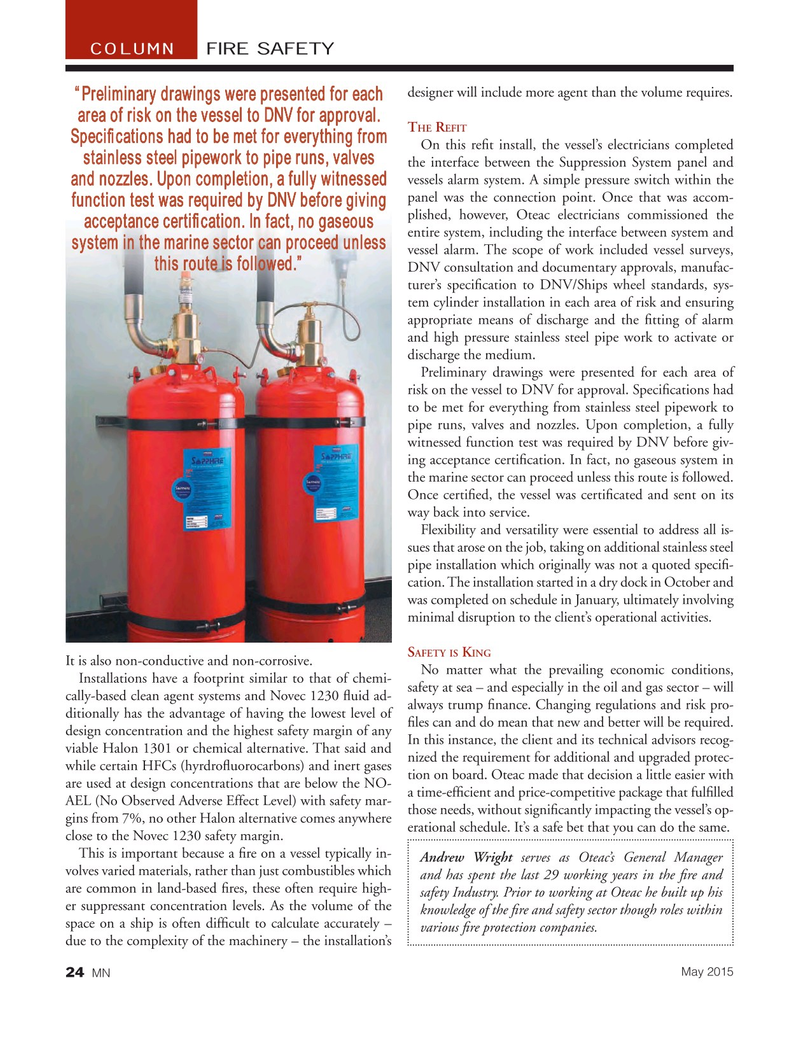
Page 24: of Marine News Magazine (May 2015)
Offshore Annual
Read this page in Pdf, Flash or Html5 edition of May 2015 Marine News Magazine
COLUMN FIRE SAFETY designer will include more agent than the volume requires. “Preliminary drawings were presented for each area of risk on the vessel to DNV for approval.
HE EFIT
T R
Speci? cations had to be met for everything from
On this re? t install, the vessel’s electricians completed stainless steel pipework to pipe runs, valves the interface between the Suppression System panel and vessels alarm system. A simple pressure switch within the and nozzles. Upon completion, a fully witnessed panel was the connection point. Once that was accom- function test was required by DNV before giving plished, however, Oteac electricians commissioned the acceptance certi? cation. In fact, no gaseous entire system, including the interface between system and system in the marine sector can proceed unless vessel alarm. The scope of work included vessel surveys, this route is followed.”
DNV consultation and documentary approvals, manufac- turer’s speci? cation to DNV/Ships wheel standards, sys- tem cylinder installation in each area of risk and ensuring appropriate means of discharge and the ? tting of alarm and high pressure stainless steel pipe work to activate or discharge the medium.
Preliminary drawings were presented for each area of risk on the vessel to DNV for approval. Speci? cations had to be met for everything from stainless steel pipework to pipe runs, valves and nozzles. Upon completion, a fully witnessed function test was required by DNV before giv- ing acceptance certi? cation. In fact, no gaseous system in the marine sector can proceed unless this route is followed.
Once certi? ed, the vessel was certi? cated and sent on its way back into service.
Flexibility and versatility were essential to address all is- sues that arose on the job, taking on additional stainless steel pipe installation which originally was not a quoted speci? - cation. The installation started in a dry dock in October and was completed on schedule in January, ultimately involving minimal disruption to the client’s operational activities.
S K
AFETY IS ING
It is also non-conductive and non-corrosive.
No matter what the prevailing economic conditions,
Installations have a footprint similar to that of chemi- safety at sea – and especially in the oil and gas sector – will cally-based clean agent systems and Novec 1230 ? uid ad- ditionally has the advantage of having the lowest level of always trump ? nance. Changing regulations and risk pro- ? les can and do mean that new and better will be required. design concentration and the highest safety margin of any viable Halon 1301 or chemical alternative. That said and In this instance, the client and its technical advisors recog- nized the requirement for additional and upgraded protec- while certain HFCs (hyrdro? uorocarbons) and inert gases tion on board. Oteac made that decision a little easier with are used at design concentrations that are below the NO- a time-ef? cient and price-competitive package that ful? lled
AEL (No Observed Adverse Effect Level) with safety mar- those needs, without signi? cantly impacting the vessel’s op- gins from 7%, no other Halon alternative comes anywhere erational schedule. It’s a safe bet that you can do the same.
close to the Novec 1230 safety margin.
This is important because a ? re on a vessel typically in-
Andrew Wright serves as Oteac’s General Manager volves varied materials, rather than just combustibles which and has spent the last 29 working years in the

 23
23

 25
25
